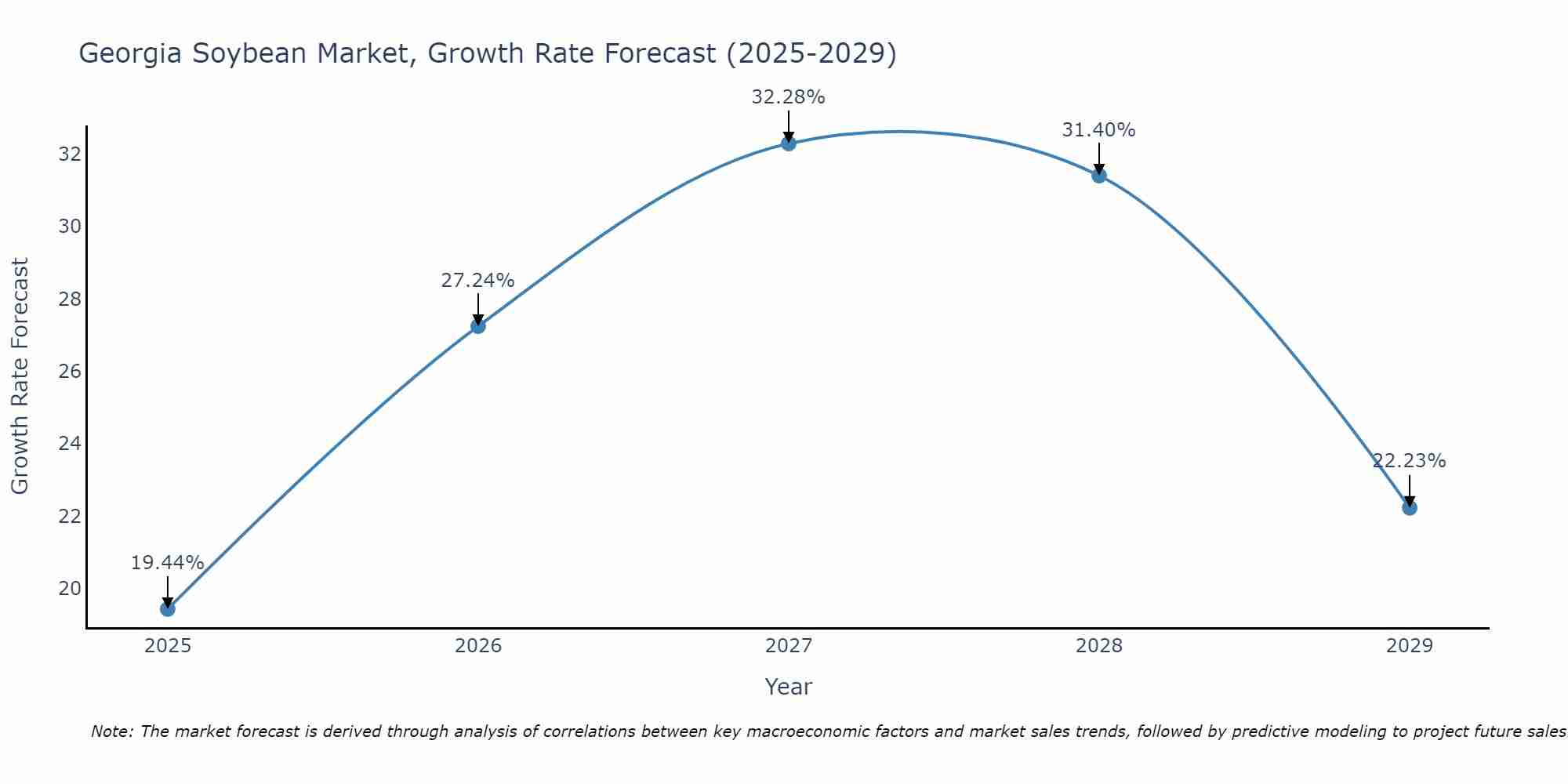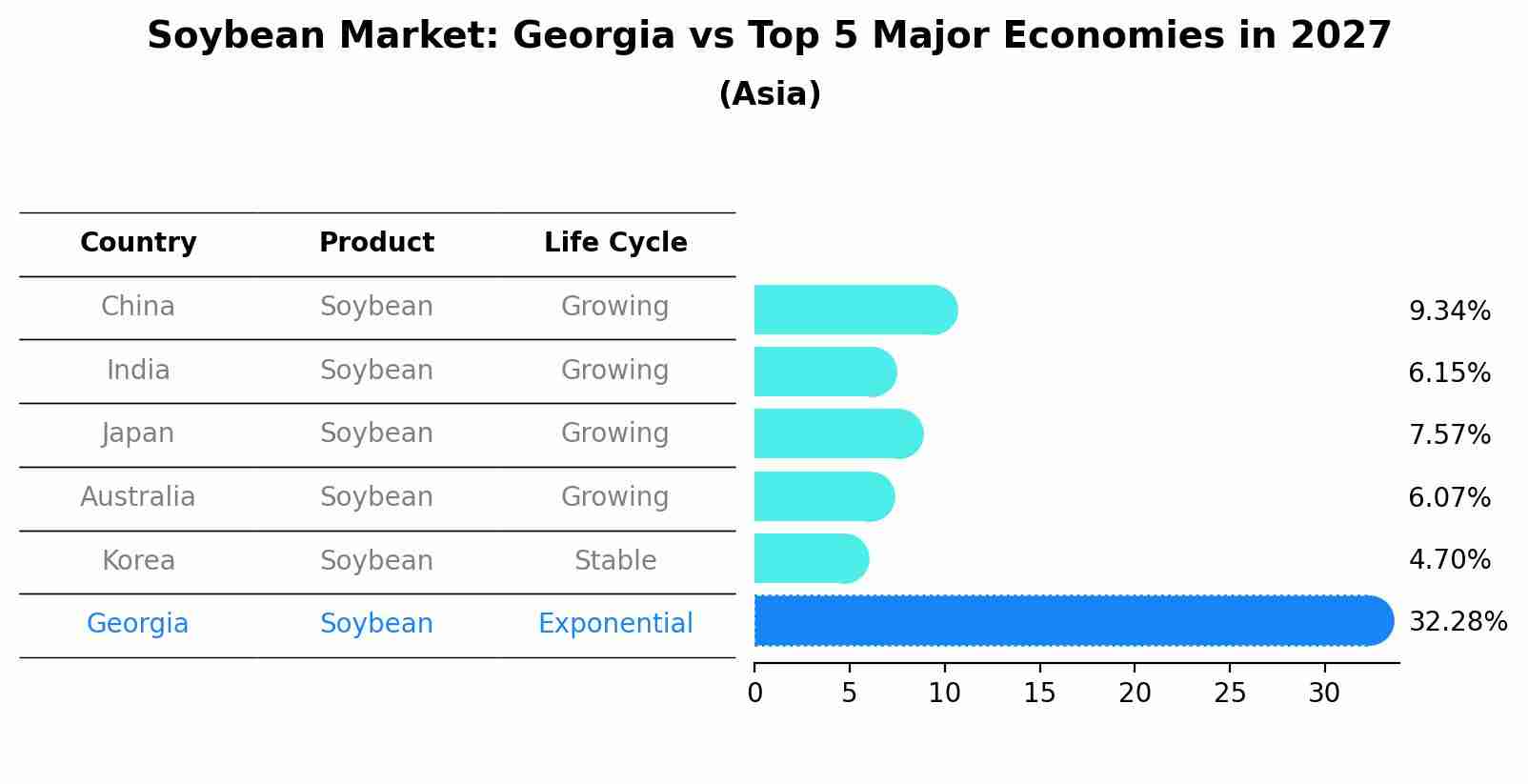Georgia Soybean Market Outlook | Revenue, Value, Industry, Forecast, Size, Analysis, Share, Trends, Growth, Companies & COVID-19 IMPACT
| Product Code: ETC224700 | Publication Date: Aug 2022 | Updated Date: Aug 2025 | Product Type: Market Research Report | |
| Publisher: 6Wresearch | Author: Shubham Deep | No. of Pages: 75 | No. of Figures: 35 | No. of Tables: 20 |
Georgia Soybean Market Size Growth Rate
The Georgia Soybean Market is projected to witness mixed growth rate patterns during 2025 to 2029. The growth rate begins at 19.44% in 2025, climbs to a high of 32.28% in 2027, and moderates to 22.23% by 2029.

Soybean Market: Georgia vs Top 5 Major Economies in 2027 (Asia)
Georgia's Soybean market is anticipated to experience a exponential growth rate of 32.28% by 2027, reflecting trends observed in the largest economy China, followed by India, Japan, Australia and South Korea.

Georgia Soybean Market Overview
The Georgia soybean market is a vital component of the state`s agriculture industry, with soybeans being one of the top crops grown in the region. Georgia farmers primarily cultivate soybeans for both domestic consumption and export purposes, with a focus on producing high-quality soybeans for various end uses such as animal feed, oil extraction, and food products. The state`s soybean market is influenced by factors such as weather conditions, global demand, trade policies, and commodity prices. Georgia`s proximity to major ports enables efficient transportation and export of soybeans to international markets, contributing to the state`s economy. Additionally, advancements in technology and sustainable farming practices play a significant role in enhancing productivity and ensuring the competitiveness of Georgia`s soybean industry in the global market.
Georgia Soybean Market Trends
The Georgia soybean market is experiencing several key trends. One notable trend is the increasing adoption of sustainable farming practices among soybean growers in the state, driven by consumer demand for environmentally friendly products. Another trend is the growing interest in soybean-based products, such as plant-based protein alternatives, which is creating new opportunities for Georgia soybean farmers. Additionally, there is a focus on technological advancements in agriculture, with many farmers incorporating precision farming techniques and advanced machinery to improve efficiency and yield. Overall, the Georgia soybean market is evolving towards sustainability, innovation, and diversification to meet the changing demands of consumers and the agricultural industry.
Georgia Soybean Market Challenges
In the Georgia soybean market, one of the key challenges faced is competition from other crops such as corn and cotton, which have historically dominated the agricultural landscape in the state. This competition creates pricing pressure for soybean farmers and can impact their profitability. Additionally, fluctuations in weather patterns, pest infestations, and diseases pose significant risks to soybean yields in Georgia. Farmers also need to navigate complex market dynamics, trade policies, and regulations that can impact their ability to access export markets and secure competitive prices for their soybeans. Overall, the Georgia soybean market faces challenges related to market saturation, external factors affecting crop yields, and the need for strategic planning to remain competitive in the agricultural industry.
Georgia Soybean Market Investment Opportunities
Investment opportunities in the Georgia soybean market include potential growth in demand due to increasing global consumption of soy products for food, feed, and industrial purposes. Georgia`s favorable climate and soil conditions make it well-suited for soybean cultivation, leading to the possibility of increased production and export opportunities. Investors can consider investing in soybean farming operations, processing facilities, or trading companies that work with soybeans. Additionally, advancements in technology and sustainable farming practices in the soybean industry present opportunities for innovation and efficiency improvements. Monitoring market trends, government policies, and international trade agreements can help investors stay informed and capitalize on potential opportunities in the dynamic Georgia soybean market.
Georgia Soybean Market Government Policy
Government policies related to the Georgia Soybean Market include subsidies, trade agreements, and agricultural regulations. Subsidies provided by the government aim to support soybean farmers by offering financial assistance, insurance, and price guarantees. Trade agreements play a crucial role in determining the export and import of soybeans, impacting market prices and access to international markets. Additionally, agricultural regulations set by the government ensure quality control, environmental sustainability, and food safety standards in the production and distribution of soybeans. These policies collectively influence the profitability and competitiveness of the Georgia Soybean Market, shaping the industry`s growth and stability.
Georgia Soybean Market Future Outlook
The future outlook for the Georgia Soybean Market appears promising, driven by increasing global demand for soybeans and their byproducts. Georgia`s favorable climate and soil conditions make it well-suited for soybean cultivation, with potential for expansion in acreage and yield improvement through technological advancements. Furthermore, the growing interest in sustainable and plant-based products among consumers is expected to further boost demand for soybeans. However, challenges such as fluctuating commodity prices and potential trade disruptions may impact the market`s growth. Overall, with strategic investments in research and innovation, coupled with effective market strategies, the Georgia Soybean Market has the potential to capitalize on these opportunities and maintain a competitive position in the industry.
Key Highlights of the Report:
- Georgia Soybean Market Outlook
- Market Size of Georgia Soybean Market, 2021
- Forecast of Georgia Soybean Market, 2031
- Historical Data and Forecast of Georgia Soybean Revenues & Volume for the Period 2018 - 2031
- Georgia Soybean Market Trend Evolution
- Georgia Soybean Market Drivers and Challenges
- Georgia Soybean Price Trends
- Georgia Soybean Porter's Five Forces
- Georgia Soybean Industry Life Cycle
- Historical Data and Forecast of Georgia Soybean Market Revenues & Volume By Applications for the Period 2018 - 2031
- Historical Data and Forecast of Georgia Soybean Market Revenues & Volume By Crush for the Period 2018 - 2031
- Historical Data and Forecast of Georgia Soybean Market Revenues & Volume By Feed Use for the Period 2018 - 2031
- Historical Data and Forecast of Georgia Soybean Market Revenues & Volume By Food Use for the Period 2018 - 2031
- Georgia Soybean Import Export Trade Statistics
- Market Opportunity Assessment By Applications
- Georgia Soybean Top Companies Market Share
- Georgia Soybean Competitive Benchmarking By Technical and Operational Parameters
- Georgia Soybean Company Profiles
- Georgia Soybean Key Strategic Recommendations
Frequently Asked Questions About the Market Study (FAQs):
1 Executive Summary |
2 Introduction |
2.1 Key Highlights of the Report |
2.2 Report Description |
2.3 Market Scope & Segmentation |
2.4 Research Methodology |
2.5 Assumptions |
3 Georgia Soybean Market Overview |
3.1 Georgia Country Macro Economic Indicators |
3.2 Georgia Soybean Market Revenues & Volume, 2021 & 2031F |
3.3 Georgia Soybean Market - Industry Life Cycle |
3.4 Georgia Soybean Market - Porter's Five Forces |
3.5 Georgia Soybean Market Revenues & Volume Share, By Applications, 2021 & 2031F |
4 Georgia Soybean Market Dynamics |
4.1 Impact Analysis |
4.2 Market Drivers |
4.2.1 Increasing demand for soybean products in food, feed, and biofuel industries |
4.2.2 Favorable government policies and subsidies supporting soybean cultivation |
4.2.3 Growing awareness about the health benefits of soybean consumption |
4.3 Market Restraints |
4.3.1 Fluctuating soybean prices in the global market |
4.3.2 Weather-related risks affecting soybean yields |
4.3.3 Competition from other oilseed crops impacting market share |
5 Georgia Soybean Market Trends |
6 Georgia Soybean Market, By Types |
6.1 Georgia Soybean Market, By Applications |
6.1.1 Overview and Analysis |
6.1.2 Georgia Soybean Market Revenues & Volume, By Applications, 2021-2031F |
6.1.3 Georgia Soybean Market Revenues & Volume, By Crush, 2021-2031F |
6.1.4 Georgia Soybean Market Revenues & Volume, By Feed Use, 2021-2031F |
6.1.5 Georgia Soybean Market Revenues & Volume, By Food Use, 2021-2031F |
7 Georgia Soybean Market Import-Export Trade Statistics |
7.1 Georgia Soybean Market Export to Major Countries |
7.2 Georgia Soybean Market Imports from Major Countries |
8 Georgia Soybean Market Key Performance Indicators |
8.1 Average yield per acre of soybeans in Georgia |
8.2 Percentage of farmers adopting sustainable soybean farming practices |
8.3 Number of new product developments using soybeans in Georgia |
9 Georgia Soybean Market - Opportunity Assessment |
9.1 Georgia Soybean Market Opportunity Assessment, By Applications, 2021 & 2031F |
10 Georgia Soybean Market - Competitive Landscape |
10.1 Georgia Soybean Market Revenue Share, By Companies, 2021 |
10.2 Georgia Soybean Market Competitive Benchmarking, By Operating and Technical Parameters |
11 Company Profiles |
12 Recommendations |
13 Disclaimer |
- Single User License$ 1,995
- Department License$ 2,400
- Site License$ 3,120
- Global License$ 3,795
Search
Thought Leadership and Analyst Meet
Our Clients
Related Reports
- Afghanistan Apparel Market (2026-2032) | Growth, Outlook, Industry, Segmentation, Forecast, Size, Companies, Trends, Value, Share, Analysis & Revenue
- Canada Oil and Gas Market (2026-2032) | Share, Segmentation, Value, Industry, Trends, Forecast, Analysis, Size & Revenue, Growth, Competitive Landscape, Outlook, Companies
- Germany Breakfast Food Market (2026-2032) | Industry, Share, Growth, Size, Companies, Value, Analysis, Revenue, Trends, Forecast & Outlook
- Australia Briquette Market (2025-2031) | Growth, Size, Revenue, Forecast, Analysis, Trends, Value, Share, Industry & Companies
- Vietnam System Integrator Market (2025-2031) | Size, Companies, Analysis, Industry, Value, Forecast, Growth, Trends, Revenue & Share
- ASEAN and Thailand Brain Health Supplements Market (2025-2031) | Strategy, Consumer Insights, Analysis, Investment Trends, Opportunities, Growth, Size, Share, Industry, Revenue, Segments, Value, Segmentation, Supply, Forecast, Restraints, Outlook, Competition, Drivers, Trends, Demand, Pricing Analysis, Competitive, Strategic Insights, Companies, Challenges
- ASEAN Bearings Market (2025-2031) | Strategy, Consumer Insights, Analysis, Investment Trends, Opportunities, Growth, Size, Share, Industry, Revenue, Segments, Value, Segmentation, Supply, Forecast, Restraints, Outlook, Competition, Drivers, Trends, Demand, Pricing Analysis, Competitive, Strategic Insights, Companies, Challenges
- Europe Flooring Market (2025-2031) | Outlook, Share, Industry, Trends, Forecast, Companies, Revenue, Size, Analysis, Growth & Value
- Saudi Arabia Manlift Market (2025-2031) | Outlook, Size, Growth, Trends, Companies, Industry, Revenue, Value, Share, Forecast & Analysis
- Uganda Excavator, Crane, and Wheel Loaders Market (2025-2031) | Strategy, Consumer Insights, Analysis, Investment Trends, Opportunities, Growth, Size, Share, Industry, Revenue, Segments, Value, Segmentation, Supply, Forecast, Restraints, Outlook, Competition, Drivers, Trends, Demand, Pricing Analysis, Competitive, Strategic Insights, Companies, Challenges
Industry Events and Analyst Meet
Whitepaper
- Middle East & Africa Commercial Security Market Click here to view more.
- Middle East & Africa Fire Safety Systems & Equipment Market Click here to view more.
- GCC Drone Market Click here to view more.
- Middle East Lighting Fixture Market Click here to view more.
- GCC Physical & Perimeter Security Market Click here to view more.
6WResearch In News
- Doha a strategic location for EV manufacturing hub: IPA Qatar
- Demand for luxury TVs surging in the GCC, says Samsung
- Empowering Growth: The Thriving Journey of Bangladesh’s Cable Industry
- Demand for luxury TVs surging in the GCC, says Samsung
- Video call with a traditional healer? Once unthinkable, it’s now common in South Africa
- Intelligent Buildings To Smooth GCC’s Path To Net Zero


















